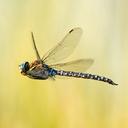United States and Canada
This is a common species at higher elevations. It has a black cross-stripe on the face and the frontal thoracic stripes are well-developed. The lateral thoracic stripes are broad and straight. The pale anterior stripe is blue and narrowed above and yellowish below. The pale lateral spots on abdominal segments 1-2 are yellowish-green with the remaining pale spots blue. The male and blue form female are as above. Pale markings may also be green or yellow in females.
Size: Total length: 65-74 mm; abdomen: 47-54 mm; hindwing: 39-45 mm.
Similar Species (south-central US): The bicolored appearance and shape of anterior lateral thoracic stripe is distinctive. Male Variable Darners (A. interrupta) have short frontal thoracic stripes and pale blue spots laterally on segments 1-2.
Habitat: As its name implies it frequents marshes and ponds with sedges.
Natural History: Rush Darner barely ranges into the south-central United States (Taos, New Mexico). They patrol all day until dark along forested edges.
Distribution: Throughout Canada and Rocky Mountains of the U.S.
Source: Abbott, J.C. 2006-2010. OdonataCentral: An online resource for the distribution and identification of Odonata. Available at OdonataCentral.
Edited by Drew Weber (9/24/2015).
